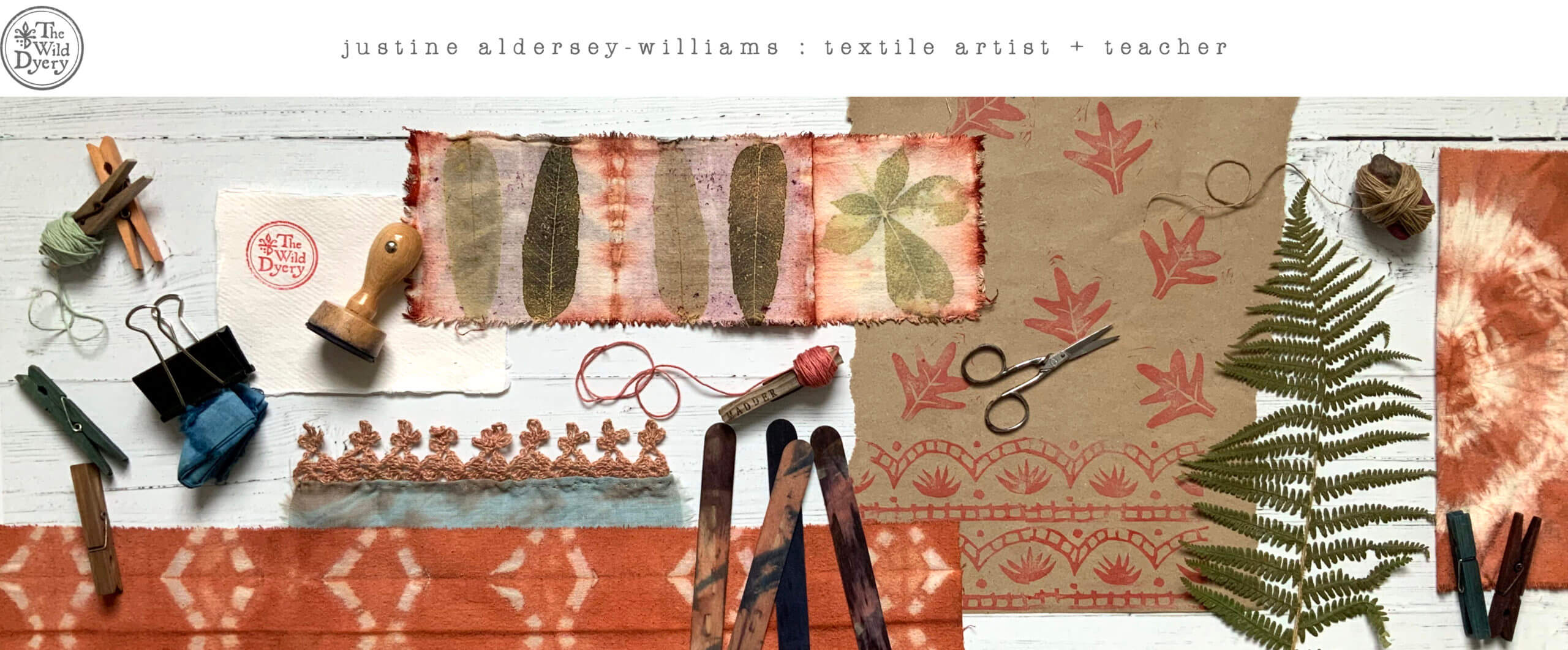A – B – C – D – E – F – G – H – I – J – K – L – M – N – O – P – Q – R – S – T – U – V – W – X – Y – Z
A
acid: substance with a pH of less than 7
accordion (concertina) fold: folding fabric or paper into a zig zag
adjective dye: any dye that requires a mordant to bond with fibres
alkali: substance with a pH of more than 7
alum: potassium aluminium sulphate – a commonly used and naturally occurring mordant
aniline: a class of synthetic dyes derived from coal tar and first discovered during the 19th century
arashi: shibori resist patterning technique also known as pole wrapping involving diagonally wrapping cloth around a pole before binding with string or elastic bands and scrunching to the bottom of the pole
B
bundle dyeing: creating contact between plant dye material and fabric/paper by folding or gathering tightly so colour transfers
boro textiles: rags or scraps of cloth up cycled using patchwork and embroidery to create new fabric
C
cellulose fabric: fabric made from plant material e.g. cotton, linen, hemp
chemical: any substance used in or resulting from a reaction involving changes to atoms or molecules
concertina (accordion) fold: folding fabric or paper into a zig zag
D
dye: colour producing organic compounds that are soluble in liquid
dye blanket: a piece of cloth/paper pre-soaked in dye and placed on top leaves and fabric before bundling in order to transfer its colour
dyery: old name for a place that dyes fabrics, yarns etc.
E
eco print: term coined by India Flint to describe contact printing with natural flora
exhaust dye: colour remaining in a vat after the first dyeing session which can be used again
extract dye: a concentrated powder, crystaline or liquid form of a natural dye
F
fast: dyes that remain their original colour when exposed to sunlight or when washed e.g. colour/light/wash fast
flora: Latin Goddess of flowers and word describing plants of a certain region
fugitive dye: colours that fade quickly in sunlight or when washed e.g. berry stains
I
iron blanket: a piece of cloth/paper pre-soaked in iron (rust) water and placed on top leaves and fabric before bundling in order to ‘sadden’ fabric underneath or create dark outlines around plant shapes
itajime: a shibori resist patterning technique involving folding then binding fabric between pieces of wood or a clamp
M
mellowing: term used to describe a sometimes desirable fading of colour over time
modifier: a substance that attaches to a dye molecule thereby shifting the colour
mordant: a substance that creates a molecular bond between fibre and dye thereby fixing it
N
ne-maki: shibori resist patterning technique involving tying string or elastic around an object such as a pebble or marble
P
pigment: insoluble colour particles that can be fixed to cloth or paper etc. using a binding agent
prepared for dyeing P.F.D.: a fabric, fibre or garment which has been desized, scoured and bleached but processed without optical brighteners or softeners which can interfere with dye uptake
primary colours: red, yellow and blue. When mixed, they create secondary and tertiary colours
protein fabric: fabric made from animal materials e.g. silk, wool
R
resist: a method of preventing dye from absorbing into fabric or paper etc. often creating designs or patterns e.g. shibori, tie-dye screen printing, ikat, batik
R.T.D. ready to dye: see ‘prepared for dyeing’ above
S
saddening: modifying a dye with iron causes the original colour to darken or ‘sadden’
scouring: the process of washing fibres to remove natural oils or manufacturing coatings that would otherwise prevent the absorption of dye
secondary colours: orange, green and purple. Created by mixing the primary colours, red, yellow and blue
shibori: resist patterning technique meaning ‘squeezed’ in Japanese
substantive dye: dyes that bond with fibres without the use of a mordant
sumptuary: a law that restricts private expenditure on certain items
sustainability: not causing harm to the environment or depleting natural resources
synthetic: a human-made dye originally derived from coal-tar but now usually synthesized from benzene and its derivatives
T
tertitary colours: any primary colour combined with a secondary colour
U
up cycling: re-useing an old product or material to create something new
V
vat: refers to a container for liquid but also describes an insoluable dye such as indigo which requires reduction process to become viable
W
W.O.F.: weight of fibre





